
Top 20 Most Famous Figurative Painters Today
A Reasoned Anthology
As always, for our top lists, we rely on Artfacts—the home of the artist ranking—mapping the art world and using objective data and career facts to measure the pertinence of artists in today’s art world. By doing so, we are able to create a reasoned selection without imposing our personal preferences and subjective opinions. Yet, three questions required further curation: What is a ‘figurative?’ What is ‘a painter?’ And what means ‘today?’
By doing so, we have excluded artists who were not ‘figurative enough,’ such as Rashid Johnson or Yayoi Kusama, who often use figurative elements but in an abstract manner. Other artists have painted figuratively but are not pure painters; think of artists such as Tracey Emin, who has created terrific figurative paintings lately but is predominantly known for her multidisciplinary practice, and William Kentridge, who primarily works on paper or prints. To conclude, some artists are living figurative painters but are no longer creating new figurative works, resulting in the inevitable exclusion of, for instance, Gerhard Richter and David Hockney.
Michael Armitage, born in 1984 in Nairobi, Kenya, is a contemporary painter who works and lives between Nairobi and London, the United Kingdom. He is renowned for his unique approach to painting, utilizing Lubugo, a traditional Ugandan bark cloth that he manipulates to create a textured, dynamic surface for his artworks. This choice of material reflects his intent to both situate and destabilize the subjects of his paintings, which often explore complex narratives around East African culture, politics, and society. His work is characterized by influences from the landscapes and urban scenes of East Africa to the region’s colonial architecture and vibrant wildlife. Yet, underneath the colorful, dream-like quality of his work lies a poignant critique of social inequality and political tension in Kenya.
Armitage’s work has been extensively exhibited internationally, with solo exhibitions at prestigious institutions such as Kunsthaus Bregenz, Austria; White Cube Bermondsey, London; Kunsthalle Basel; and the Royal Academy, London. His group exhibitions include participation in major venues like Tate Modern, London; The Museum of Fine Arts, Houston; and the Astrup Fearnley Museum of Modern Art, Oslo, among others. In 2022, Armitage was honored by being elected a Royal Academician in the category of painting by the Royal Academy of Arts, London.1
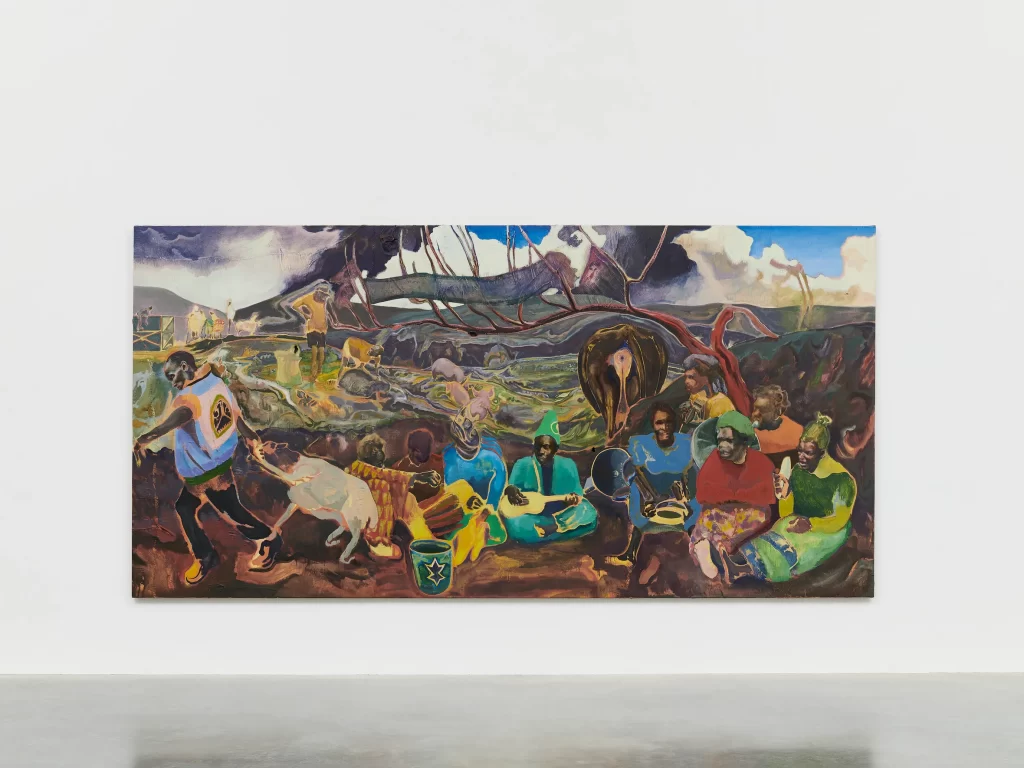
Tschabalala Self, born in 1990 in Harlem, New York, is an artist who innovatively blends painting and printmaking to explore the depiction of the black female body. Self creates exaggerated representations of female forms through a unique synthesis of sewn, printed, and painted materials, engaging with various artistic and craft traditions. The prominent biological features in her work reflect cultural and personal narratives surrounding race and gender. Self articulates that her practice both embraces and challenges the preconceptions about the black female body, aiming to disorient and generate new perspectives. She seeks to offer alternative narratives to the voyeuristic tendencies directed at gendered and racialized bodies, which are simultaneously revered and marginalized.
Currently residing and working in Hudson Valley, New York, Tschabalala Self has been featured in numerous significant exhibitions both solo and group. Upcoming shows in 2024 include presentations at the Espoo Museum of Modern Art in Espoo, Highline and Brooklyn Museum in New York, FLAG Foundation in New York, and the Barbican in London. Her recent exhibitions have taken place at venues such as CC Strombeek in Grimbergen, Belgium, Desert X in Coachella Valley, Kunstmuseum St Gallen, and Le Consortium in Dijon. Additionally, her work has been showcased in various prominent institutions like the Haus der Kunst in Munich, Kunsthalle Düsseldorf, Baltimore Museum of Art, ICA in Boston, and the Hammer Museum in Los Angeles. Her involvement in residencies and biennials, including the Performa 2021 Biennial and the Studio Museum Artists in Residence at MoMA PS1, further highlights her dynamic contribution to contemporary art.2

Wilhelm Sasnal, born in 1972 in Tarnów, Poland, began his academic journey at the Krakow University of Technology, studying architecture from 1992 to 1994. He later shifted his focus to painting, pursuing and completing his education at the Academy of Fine Arts in Krakow between 1994 and 1999. Over the past two decades, Sasnal has distinguished himself as a leading figure in contemporary European painting.
His artistic process frequently involves the use of photographic sources, which may include film stills, art reproductions, elements of pop culture, or images from his own mobile phone. These images serve as foundational elements for his paintings, which he transforms through varying degrees of distortion, simplification, or abstraction. Sasnal’s work engages with significant historical events, such as the Holocaust, and captures pop culture icons alongside everyday scenes and subjects, presenting a rich narrative of post-Communist Poland during a period of profound socio-political change.3
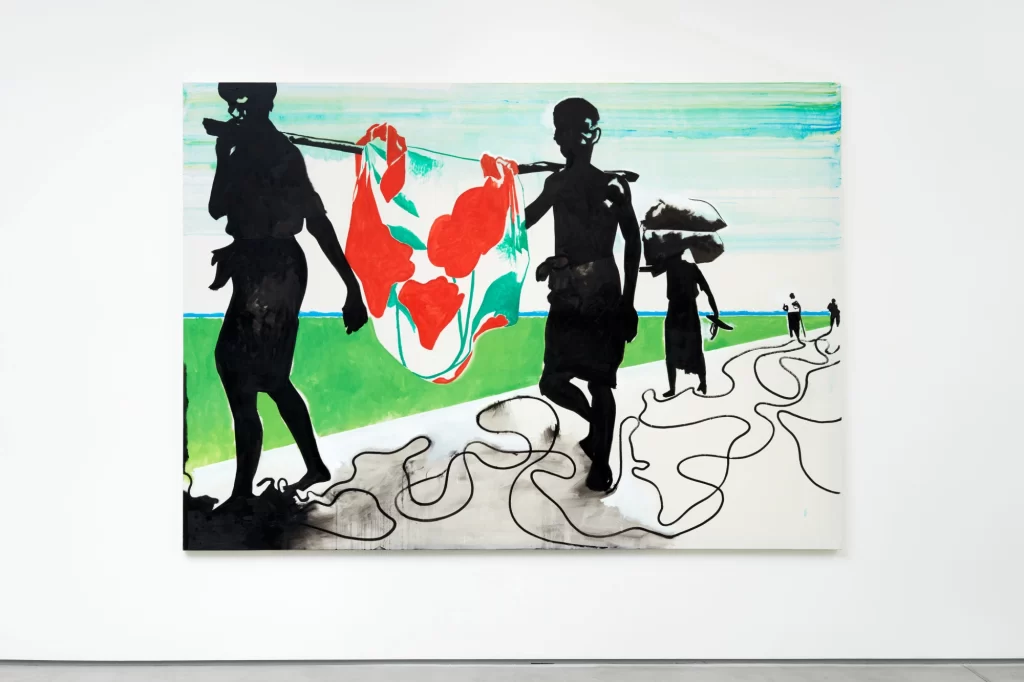
Eric Fischl was born in 1948 in New York and completed his education at the California Institute of Arts in Valencia in 1972 before moving back to New York City in 1978. Fischl’s art spans several media, including painting, sculpture, and printmaking. He is renowned for his large-scale, naturalistic portrayals of middle-class American life, influenced by his suburban background marked by themes of alcoholism and a societal fixation on image rather than substance.
His early works address controversial and often unsettling social issues, revealing the underlying sexuality and voyeuristic elements of American culture. These works feature large human-scale figures that heighten the sense of intrusion and psychological depth, resembling the Photorealism of the 1960s. During the 1980s, his style evolved to include fragmented images across multiple panels. His art has been featured in prestigious institutions such as The Metropolitan Museum of Art in New York and The Whitney Museum of American Art.4
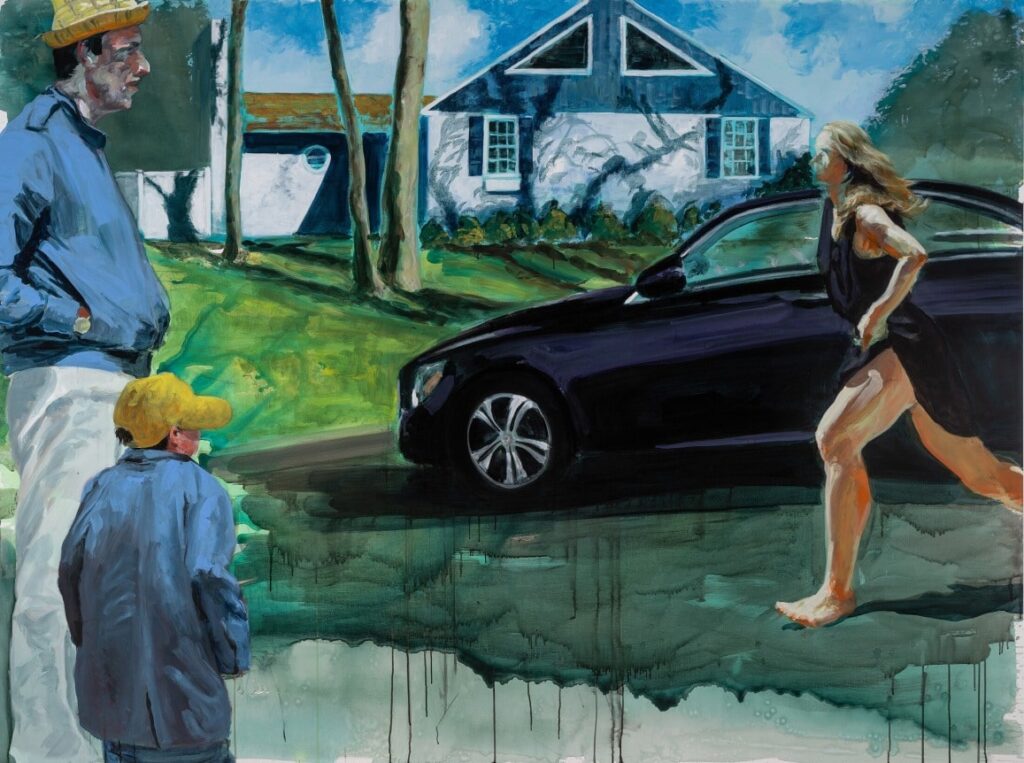
Njideka Akunyili Crosby, born in 1983 in Enugu, Nigeria, currently residing and working in Los Angeles, is an artist known for her complex visual narratives that combine painted images of personal scenes with photographic transfers from Nigerian magazines and other media sources. Her works, which she creates from her extensive personal archive, explore social and personal aspects of contemporary life, deeply reflecting on the nuances of African diasporic identity.
She is a 2017 MacArthur Fellow and has received numerous prestigious awards, including the Prix Canson in 2016, the Next Generation Prize from the New Museum in 2015, the Joyce Alexander Wein Artist Prize in 2015, and the James Dicke Contemporary Artist Prize from the Smithsonian American Art Museum in 2014. She was also an Artist in Residence at The Studio Museum in Harlem from 2011 to 2012. Her works are included in numerous prominent museum collections worldwide, including the Baltimore Museum of Art, the Los Angeles County Museum of Art, The Metropolitan Museum of Art in New York, and the Tate in the UK, among others.5
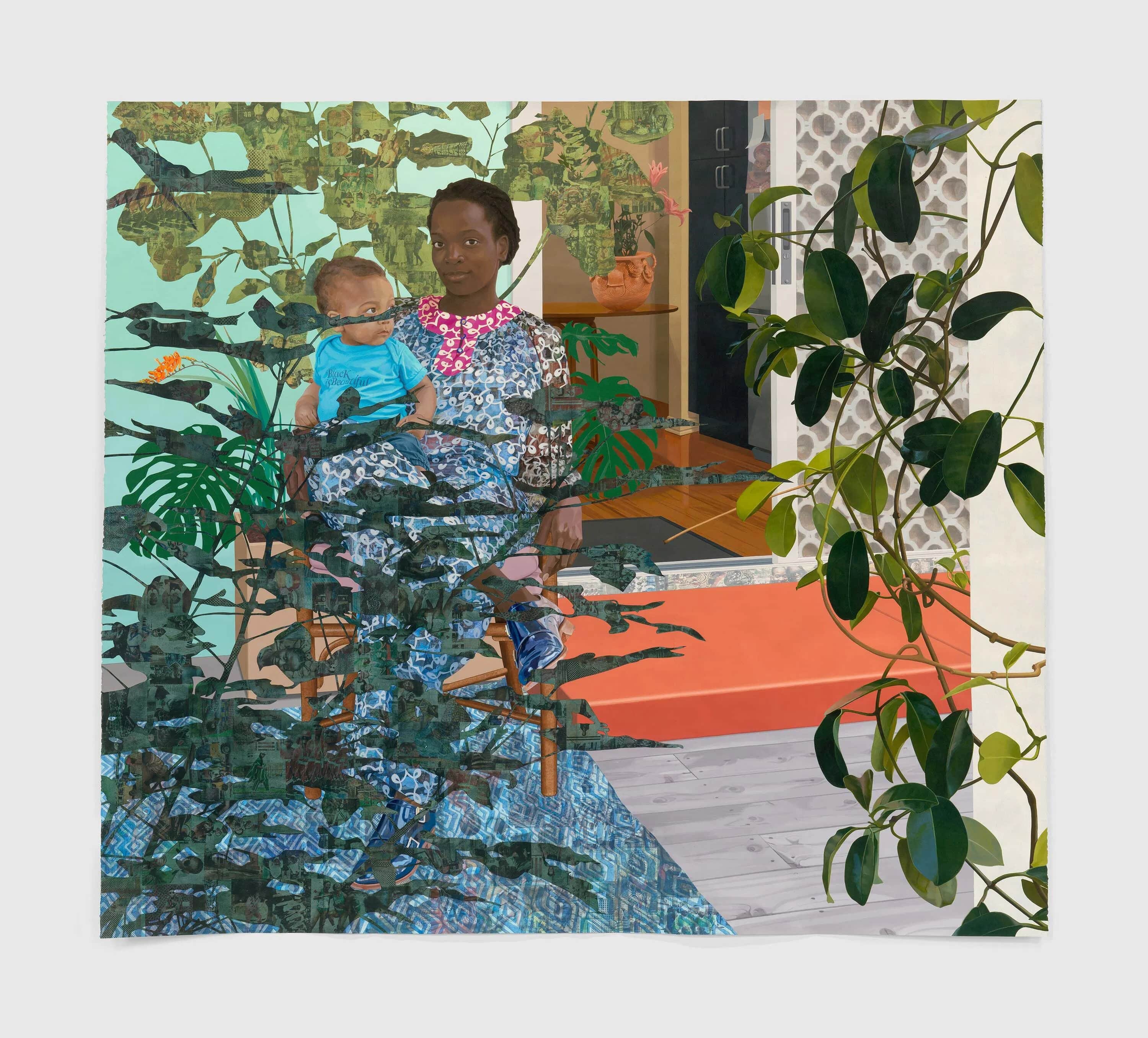
Cecily Brown, born in 1969 in London, residing and working in New York, is an artist known for her dynamic paintings, which oscillate between abstract and figurative modes, imbued with an erotic vibrancy and a palette that captures the eye. Her work references a range of influences from the annals of Western painting, such as Paolo Veronese, Peter Paul Rubens, Edgar Degas, Willem de Kooning, Francis Bacon, and Joan Mitchell, along with elements from popular culture. Brown’s paintings break free from conventional narrative constraints, achieving a remarkable fluidity in both visual and thematic terms. Her treatment of the nude figure, often vigorous, seeks to liberate traditional subjects from their expected interpretations, creating images that reside in a continually active presence.
Brown’s artistic approach often appears to magically transform paint into flesh, with human forms emerging from a vibrant and fragmented discourse on desire, mortality, and life. Her early work from the mid-1990s features hedonistic rabbits juxtaposed with still-life elements, evolving into more complex and orgiastic scenes that have brought her widespread acclaim. Brown describes painting as a form of alchemy, where both paint and image metamorphose into something entirely new. Over the last two decades, Brown’s art has grown in both scale and complexity, enriching its palette and allusions and integrating aspects of landscape. Her creative process includes elements of improvisation, allowing spontaneous strokes to guide the evolution of her paintings. Brown’s contributions to the art world have been recognized through solo exhibitions at major institutions such as the Museum of Fine Arts in Boston, the Hirshhorn Museum and Sculpture Garden in Washington, DC, and the Museo Nacional Centro de Arte Reina Sofía in Madrid.6

Tala Madani, born in 1981 in Tehran, Iran, currently residing and working in Los Angeles, is a contemporary painter renowned for her compelling visuals that stimulate critical reflection on themes such as gender, political authority, and representation in art. Madani uses bodily fluids and beams of light emanating from their bodies as metaphors to explore the expressive potential of paint. Her art intertwines slapstick humor with underlying violence, portraying creation and destruction as one, thereby offering a commentary on contemporary power dynamics. Her unique approach to figuration melds modernist influences with a contemporary flair for sequencing and motion, drawing significant parallels with cartoons, cinema, and other time-based media such as animation.
Madani’s work has been showcased in solo exhibitions at prominent institutions globally, including The Museum of Contemporary Art in Los Angeles (2023), Start Museum in Shanghai (2020), Mori Art Museum in Tokyo (2019), and Secession in Vienna (2019), among others. She also participated in significant group exhibitions such as the 16th Istanbul Biennial (2019), the Whitney Biennial 2017 at the Whitney Museum of American Art in New York, and Made in L.A. 2014 at the Hammer Museum in Los Angeles. Her works are held in permanent collections in several major museums, including the Moderna Museet in Stockholm and Malmö, the Guggenheim Museum in New York, and the Tate Modern in London.7
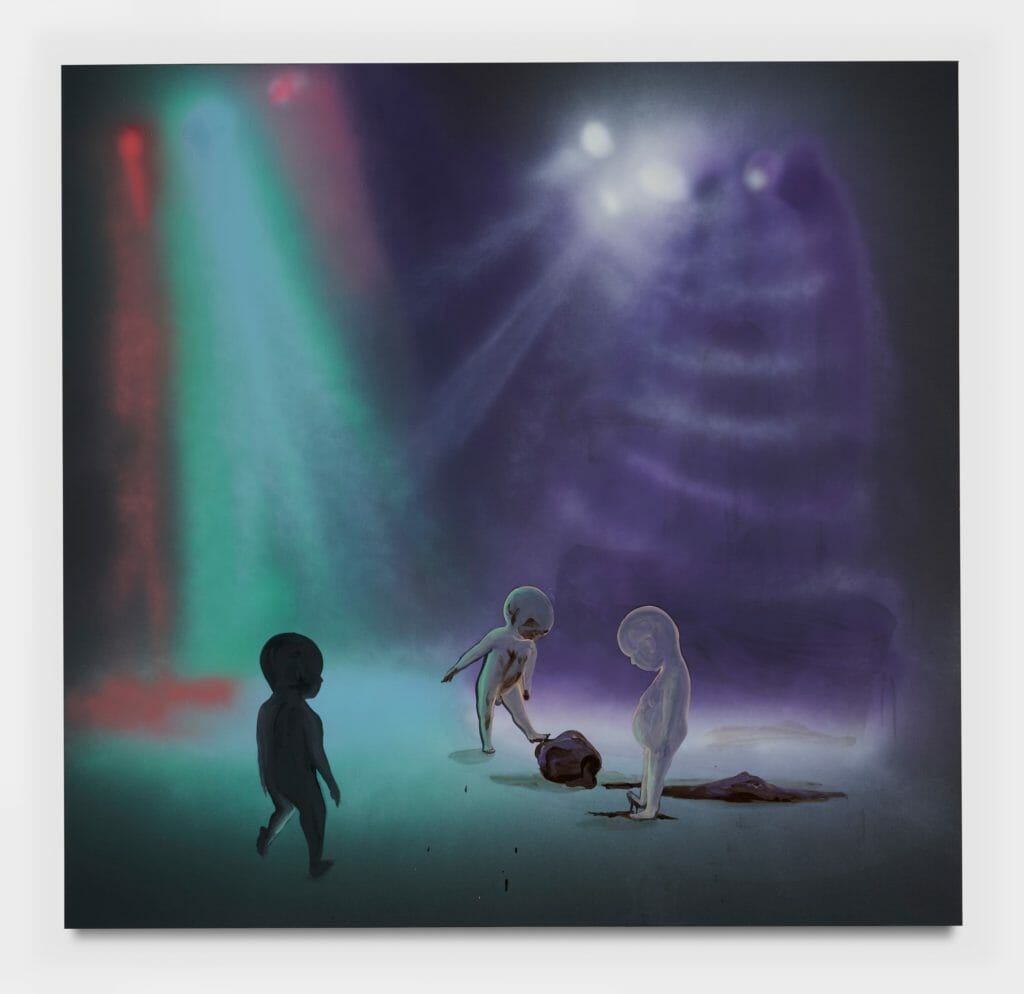
Firelei Báez, born in 1981 in Santiago de los Caballeros, Dominican Republic, works and resides in New York. She infuses her work with an exploration of diasporic narratives. Báez reinterprets historical and visual references, often featuring powerful female figures and merging elements such as hair textures, textile patterns, plant life, and motifs from folklore, literature, healing, and resistance. These elements are connected to themes from science fiction and fantasy to portray identities as dynamic and evolving. Báez’s art is deeply influenced by the complex heritage and ethnic tensions of Hispaniola.
Her work spans a range of diasporic stories, from self-portraiture to Dominican ciguapas, 18th-century tignons mandated for women of color in New Orleans, and the Black Panther Movement’s iconography. She frequently utilizes historical materials like maps and travelogues as canvases, overlaying them with figures that challenge and transcend conventional boundaries of race, class, and landscape. Her solo exhibitions have been featured at prestigious venues such as the Louisiana Museum of Modern Art, Humlebaek; The Museum of Modern Art, New York; and The Studio Museum in Harlem.8
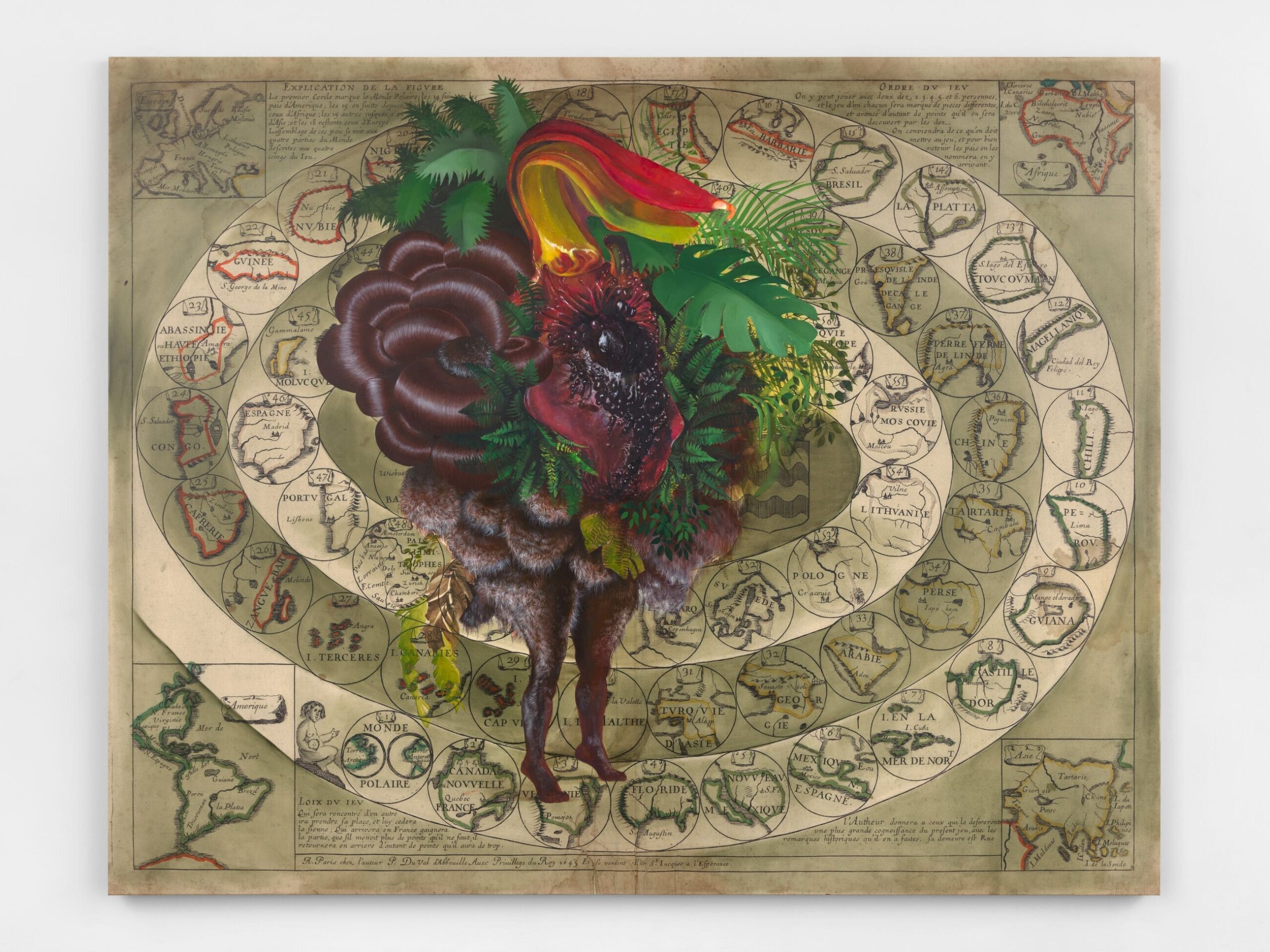
Lynette Yiadom-Boakye, born in 1977 in London, is a distinguished artist known for her enigmatic portraits of fictional characters. These figures are not anchored in any specific time or place, emerging instead from a blend of various sources, including people, objects, thoughts, photographs, and Yiadom-Boakye’s own drawings and memories. This intentional ambiguity invites viewers to project their imaginations onto the canvas. Her work is grounded in the traditional elements of painting—line, color, and scale—and maintains a contemporary approach both in subject matter and technique. Additionally, her practice integrates poetic language, making the titles of her paintings an integral part of her expressive strategy, serving not to define but to enhance the viewer’s engagement with the art.
Her talent has been recognized with several awards, including the prestigious Carnegie Prize in 2018 for her contribution to the Carnegie International, 57th Edition. She was also a finalist for the Turner Prize in 2013. Her work has been showcased at the New Museum and Studio Museum in New York, Haus Der Kunst in Munich, Kunsthalle Basel in Switzerland, Serpentine Gallery in London, and the Utah Museum of Fine Arts. She participated in the inaugural Ghanaian pavilion at the 2019 Venice Biennale, and her most recent exhibition, “No Twilight Too Mighty,” was displayed at the Guggenheim Bilbao in 2023.9

Born in 1958 in Mortsel, Belgium, residing and working in Antwerp, Luc Tuymans is widely recognized as a pivotal figure in contemporary painting. Luc Tuymans has revolutionized figurative painting with a unique approach that eschews traditional narrative structures, focusing instead on the nuanced layering of information within specific scenes and symbols. Drawing on a diverse array of preexisting imagery, his works are characterized by a subdued color palette that evokes the quality of a blurred memory or a fading moment. Despite their seemingly quiet and subdued appearance, Tuymans’ paintings are deeply imbued with moral complexity. They thoughtfully probe both historical and everyday subjects, questioning the ways in which history is portrayed alongside more mundane topics, as his canvases challenge and reinterpret the traditional concepts of monumentality, emphasizing the uncertain and often ambiguous nature of meaning.10
Tuymans’s work has been featured in a range of solo exhibitions at leading international institutions. Noteworthy upcoming projects include a temporary mural, “L’Orphelin,” at the Musée du Louvre in Paris, starting in May 2024, and a major exhibition, “The Past,” at the UCCA Center for Contemporary Art in Beijing in November 2024. His exhibitions have been hosted at renowned venues such as Palazzo Grassi in Venice and the De Pont Museum in Tilburg, among others. Throughout his career, Tuymans has received several honors, including the Medal of Honor from the International Congress of Contemporary Painting in Porto in 2019, and the Coutts Contemporary Art Foundation Award in 2000. His work is held in prominent collections worldwide, including the Art Institute of Chicago, Centre Georges Pompidou in Paris, and The Museum of Modern Art in New York.11
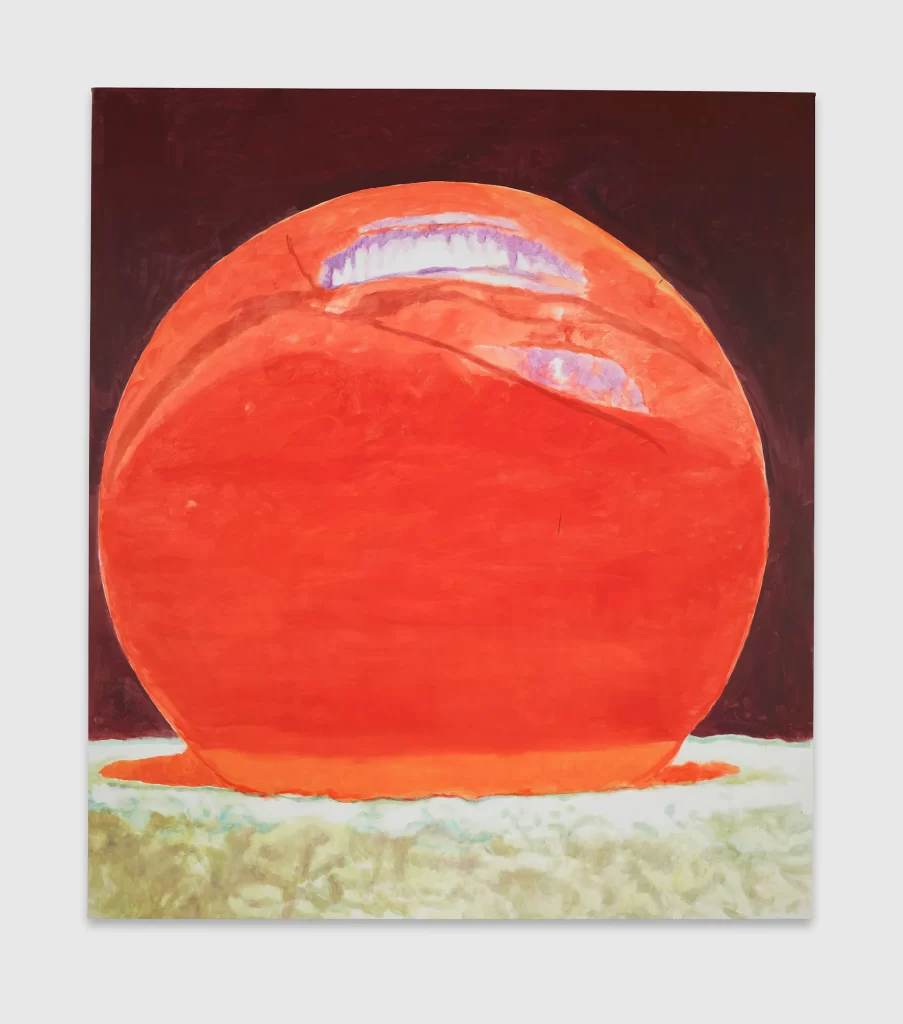
Born in 1977 in Los Angeles, California, residing and working between New York, Beijing, and Dakar, Kehinde Wiley has established himself as a modern successor within the tradition of portrait painting, aligning with historical figures such as Reynolds, Titian, and Ingres. Wiley is known for his vivid portrayal of urban black and brown men from around the world, utilizing the classical visual rhetoric typically associated with heroism, power, and majesty. Wiley’s approach integrates the grandeur and aesthetics of historical opulence and prestige with subjects from contemporary urban settings. His portraits, often larger than life, challenge traditional tropes by merging historical and contemporary elements and addressing the representation of masculinity and racial identity.
His works are featured in numerous major collections globally, including the National Portrait Gallery in Washington D.C., the Los Angeles County Museum of Art, and the Metropolitan Museum of Art in New York. Wiley was awarded the Medal of Arts by the U.S. Department of State in 2015 and received the W.E.B. Du Bois medal in 2018 for his contributions to African and African-American history and culture. Notably, in 2018, his portrait of Barack Obama was installed in the Smithsonian’s National Portrait Gallery, marking a significant recognition of his impact on contemporary art and cultural discourse.12
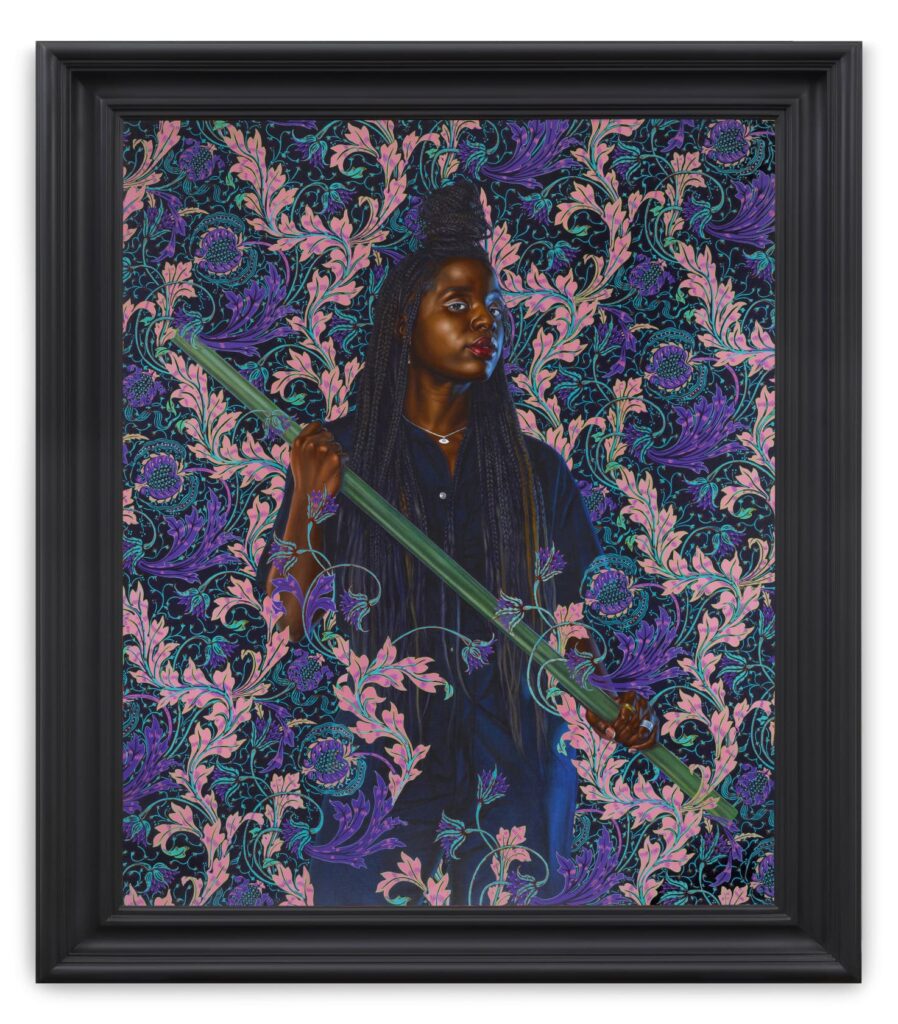
Born in 1971 in Camden, NJ, and based in Brooklyn, NY, Mickalene Thomas is an influential contemporary artist whose work encompasses paintings, collages, photography, video, and installations. Her art engages deeply with art history and popular culture to present a modern vision of female sexuality, beauty, and power. Her work reclaims agency for women, positioning them not just as subjects of desire but as empowered figures. Her settings and the use of patterns often nod to the 1960s to the 1980s—a period marked by civil rights movements, the assertion of black beauty, and feminist redefinitions of traditional beauty standards, especially among African-American women.
She has had numerous solo exhibitions at venues including the Dayton Art Institute, OH; Henry Art Gallery, Seattle, WA; Pomona College Museum of Art, Claremont, CA; and the Georgia Museum of Art, Athens, GA. Her work has also been featured in significant group exhibitions such as “Third Space / Shifting Conversations About Contemporary Art” at the Birmingham Museum of Art, AL, and “The Color Line: African American Artists and the Civil Rights in the United States” at Musée du quai Branly in Paris.13

Kerry James Marshall, born in 1955 in Birmingham, Alabama, and currently residing in Chicago, Illinois, critically examines Western art history from the Renaissance through to 20th-century American Abstraction, inserting and emphasizing themes and representations traditionally excluded from the artistic canon. Marshall’s paintings notably center on Black figures, addressing what he describes as “the lack in the image bank” and thus reshaping the narrative landscape of art. Marshall’s upbringing in Birmingham during the dawn of the American Civil Rights movement and his subsequent move to the Watts neighborhood of Los Angeles prior to the 1965 riots deeply influenced his artistic vision, which reflects enduring elements of the American experience. Art critic Carroll Dunham has highlighted Marshall’s unique ability to weave together beauty, complexity, didacticism, and formalism in his work, a feat unmatched by his contemporaries in American painting.
The last decade has seen Marshall celebrated with two major retrospectives at the Museum of Contemporary Art in Chicago in 2016 before traveling to the Metropolitan Museum of Art in New York and the Museum of Contemporary Art in Los Angeles, and a European survey between 2013 and 2014 that was exhibited in venues including the Museum van Hedendaagse Kunst Antwerpen and the Museo Nacional Centro de Arte Reina Sofía in Madrid. He has also been a prominent figure in international exhibitions, including the Venice Biennale and Documenta, and received a MacArthur Grant in 1997. His works are held in numerous prestigious public collections globally, such as the Art Institute of Chicago, the Ludwig Museum in Cologne, the Tate Modern in London, and the Museum of Modern Art in New York, among others.14

Nicole Eisenman, born in 1965 in Verdun, France, based in Brooklyn, New York, is celebrated as one of the foremost figurative painters active today. Her multifaceted artistic output includes prints, paintings, drawings, and mixed-media works, all characterized by a poignant blend of tenderness and dark humor. Eisenman infuses her work with vivid, emotionally charged, cartoonish figures that represent a mix of self-portraits, friends, and fictional characters. Her art is distinguished by dynamic, painterly strokes and vibrant colors, which frequently explore notions of community and queer love.
Eisenman’s talent has been recognized with a MacArthur Foundation Fellowship, and her works featured in significant exhibitions such as the 2019 Venice Biennale, the 2019 Whitney Biennial, and the 2017 Skulptur Projekte Münster in Germany. Her recent solo exhibitions include showings at Kunsthalle Bielefeld, Germany; Astrup Fearnley Museum of Modern Art in Oslo, Norway; and the FLAG Art Foundation in New York, NY.15
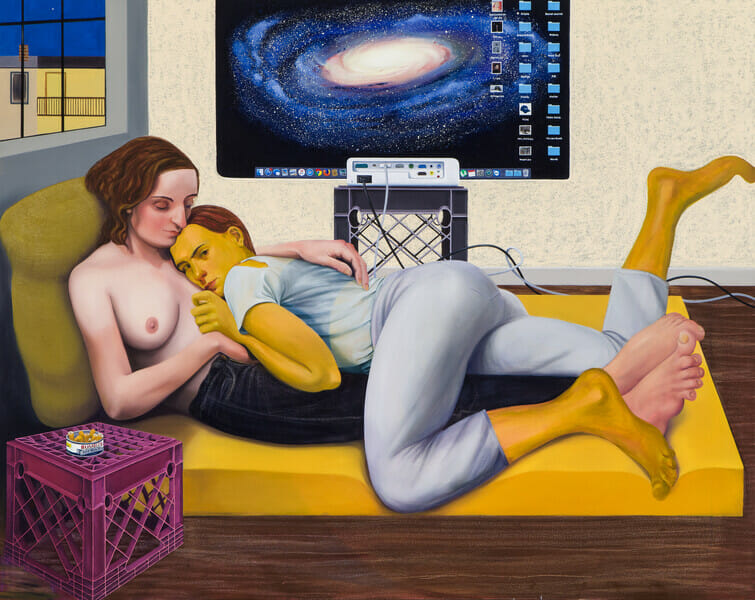
Born in 1953 in Cape Town, South Africa, Marlene Dumas has established herself as one of the most pivotal painters in contemporary art. Since relocating to Amsterdam in 1976, she has engaged deeply with themes of identity and representation. Dumas’s paintings and drawings, characterized by their gestural and often spectral quality, primarily focus on the human form, sourced from an extensive archive that includes art historical references, mass media, and personal photographs of friends and family. Her work invites viewers to consider the fluid boundaries between public and private personas.
Dumas’s pertinence has been highlighted through numerous major exhibitions at the Palazzo Grassi in Venice, Italy; the Musée d’Orsay in Paris, France; the Stedelijk Museum in Amsterdam, the Netherlands; Tate Modern in London, the United Kingdom; the Museum of Contemporary Art in Los Angeles, the United States of America; and the Fondation Beyeler in Basel, Switzerland. Her work has earned her several awards, including the Düsseldorf Art Prize in 2007, the Rolf Schock Prize in the Visual Arts in 2011, and the Johannes Vermeer Award in 2012.16
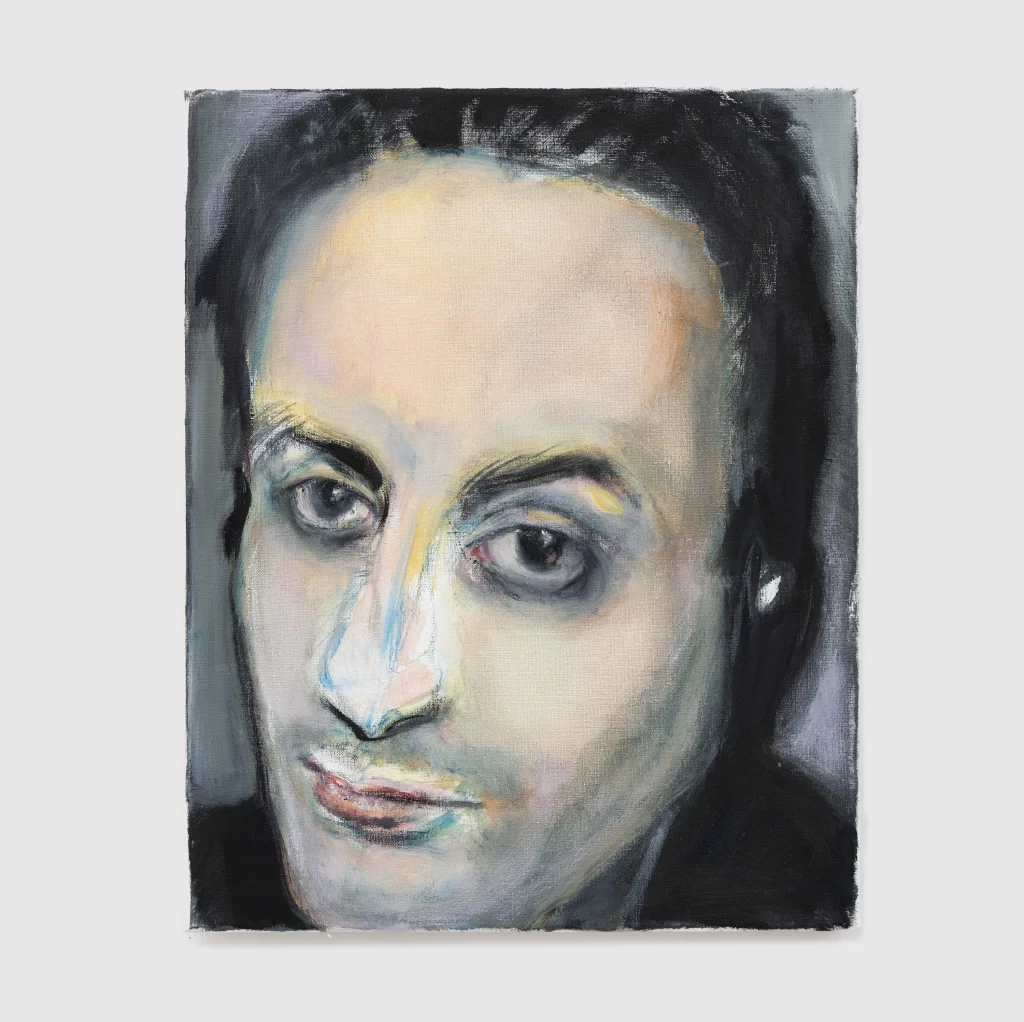
Born in 1949 in Basel, Switzerland, working and residing in Stampa, Switzerland, Miriam Cahn’s painterly practice is strongly influenced by the performance art and feminist movements of the 1960s and 1970s. During the 1980s, she became known for her expansive, richly dark drawings that often featured motifs such as warships, televisions, and fighter jets—imagery typically associated with male-dominated fields. Cahn’s early work was marked by a performative approach, using her body not just as a tool but as an integral part of the creative process. Upon reaching the age of 50, Cahn made a significant shift in her artistic practice by moving away from the monumental drawings that had defined her early career to embrace an intuitive approach to painting.
This transition in 1994 marked a continuation and evolution of her artistic exploration, now enriched by the use of color. Cahn’s adept use of color serves to accentuate specific aspects of her figures—such as breasts, lips, or eyes—thereby highlighting their fragility and vitality and imbuing them with a palpable inner life. Cahn gained international recognition through a series of notable events. She was included in Documenta 7 in 1982, though she famously removed her work in protest. This was followed by a solo exhibition at Kunsthalle Basel in 1983 and a solo presentation at the 41st Venice Biennale in 1984.17

Born in 1951 in Tsu, Mie Prefecture, Japan, residing and working between Berlin and Cologne, Germany, Leiko Ikemura is a Japanese-Swiss artist known for her profound synthesis of Eastern and Western artistic traditions. Ikemura explores a variety of themes, such as hybridity, cross-cultural dynamics, sexuality, and the life cycle through her work. Her art gracefully embraces both abstraction and figuration, employing a range of media to express raw energy and deep emotion. In her pieces, Ikemura often blurs the boundaries between species and the internal and external worlds. The materials she chooses—bronze, clay, and pigment—are deeply connected to the earth, reinforcing her thematic focus on the intrinsic link between humans and nature.
Throughout her career, Ikemura has participated in notable international exhibitions, including the Tokyo Biennale in 1988 and the Melbourne Biennial in 1999. She has been the subject of solo exhibitions at prestigious institutions such as the Sainsbury Centre for Visual Arts in Norwich (2021), Ciutat de les Arts i les Ciències in Valencia (2021), Kunstmuseum Liechtenstein (2002), The National Museum of Modern Art in Tokyo (2011), and Kunstmuseum Basel (2019). Ikemura’s works are included in several prominent collections worldwide, including the Centre Pompidou in Paris, Museum Ludwig in Cologne, Kunstmuseum Basel, Fundación Centro de Arte Caja de Burgos in Spain, The National Art Center in Tokyo, among others.18
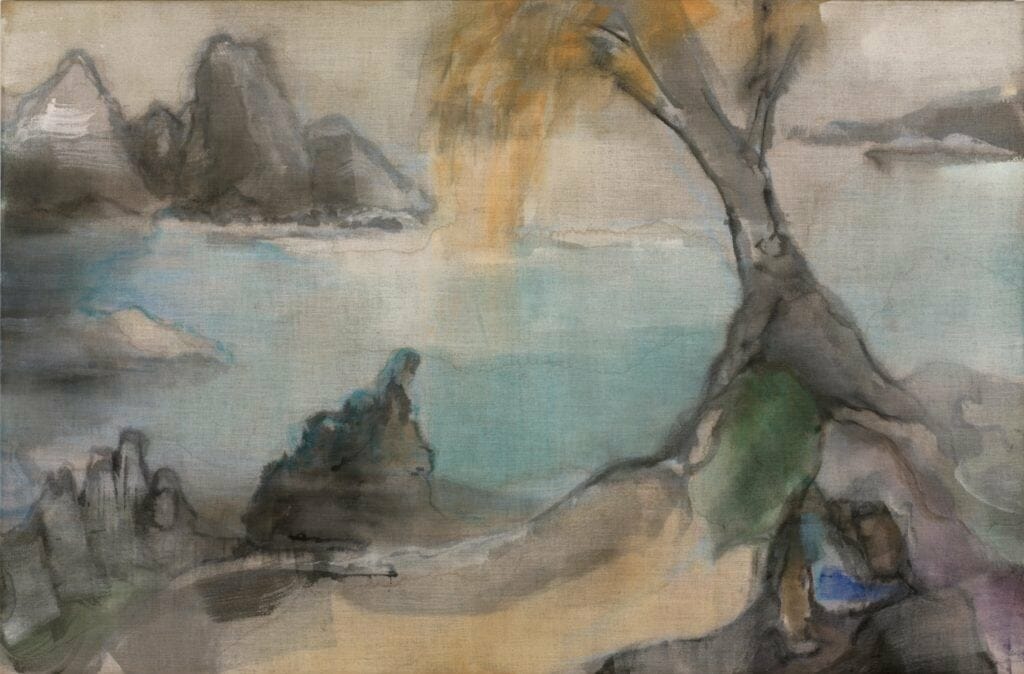
Anselm Kiefer, born in 1945 in Donaueschingen, Germany, lives and works in Barjac, Croissy, and Paris, France, examines a vast array of cultural, literary, and philosophical themes, including references to the Old and New Testaments, Kabbalah mysticism, Norse mythology, Wagner’s Ring Cycle, and the poetry of Ingeborg Bachmann and Paul Celan in his diverse painterly practice. Kiefer’s artworks serve as a visual exploration of collective memory, particularly reflecting on Germany’s post-World War II identity and the national mythology of the Third Reich. His materials—ranging from lead and concrete to textiles and tree roots—are symbolically charged, contributing to the thematic depth of his work encompassing life, death, the cosmos, and the intersections of the sacred and the profane.
Kiefer’s work has been internationally recognized and exhibited in numerous prestigious venues. Notable exhibitions include Kunsthalle Bern, Switzerland; the 39th Biennale di Venezia, Italy; and the Museum Folkwang, Germany. His work traveled from Kunsthalle Düsseldorf, Germany, to ARC Musée d’Art Moderne de la Ville de Paris, France, and the Israel Museum, Jerusalem. Recent major exhibitions include the Modern Art Museum of Fort Worth, Texas, the United States of America; the Grand Palais in Paris, France; Musée Rodin, Paris, France; and The Met Breuer in New York, the United States of America.19

Alex Katz, born in 1927 in Brooklyn, New York, where the artist continues to reside and work, has been one of the world’s leading figurative painters for seven decades—maintaining active and pertinent in today’s art scene. Katz’s art is deeply entrenched in mid-century American culture, drawing inspiration from television, film, and advertising. He is recognized as a master of modern life, known for his distinctive portraits and landscapes that feature a signature flatness and economy of line. The stylistic hallmarks of his work include a flattening of forms, simplification of details, and direct, alla-prima application of paint.
Over the years, Katz’s art has been showcased in more than 200 solo exhibitions and nearly 500 group exhibitions internationally. His works are held in nearly 100 public collections across the globe, such as the Art Institute of Chicago, the Hirshhorn Museum and Sculpture Garden at the Smithsonian Institution, the Metropolitan Museum of Art in New York, Centre Georges Pompidou in Paris, and the Tate Gallery in London, among others.20
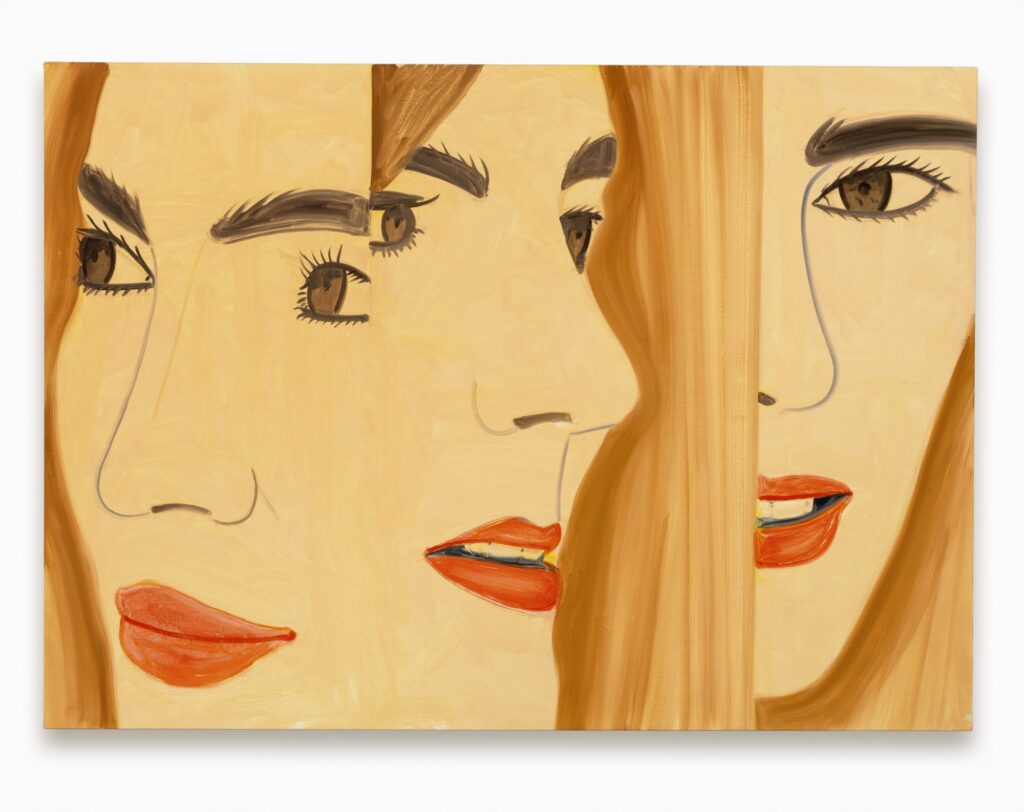
Georg Baselitz, born in 1938 in Deutschbaselitz, Saxony, Germany, lives and works at Lake Ammersee, Germany, near Salzburg, Austria, and in Imperia, Italy, he is another living icon of contemporary figurative painting, recently completing new work for the blockbuster exhibitions at the mega-galleries White Cube and Thaddaeus Ropac. Since 1969, Baselitz has been known for his revolutionary practice of painting his compositions upside down, a method he describes as a means to dissociate form from content, oscillating between abstraction and figuration. This technique marked a departure from what was considered a stagnant artistic medium at the time. His work, deeply impacted by the trauma and aftermath of the Second World War, reflects a distinctive artistic vocabulary that draws from historical influences while maintaining a unique and individualistic style.
His first major retrospective in the United States was held at the Solomon R. Guggenheim Museum, New York, in 1995, which subsequently traveled to multiple venues. Other significant retrospectives have been organized by the Musée d’Art Moderne de Paris (1996), the Royal Academy of Arts, London (2007), and the Centre Pompidou, Paris (2021). Notably, to celebrate his 80th birthday in 2018, major solo exhibitions were staged at the Fondation Beyeler, Basel; Hirshhorn Museum, Washington, D.C.; and Musée Unterlinden, Colmar, France. In 2019, Baselitz was elected to the Académie des Beaux-Arts in Paris, and he became the first living artist to have an exhibition at the Gallerie dell’Accademia, Venice.21

Last Updated on July 5, 2024

A Reasoned Anthology

Arsmonitor, Bucharest, RO

Tatjana Pieters, Ghent, BE

David Zwirner, London, UK